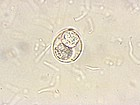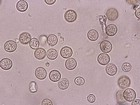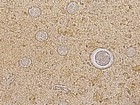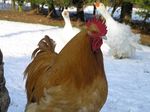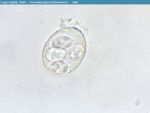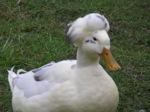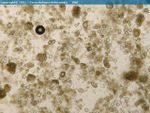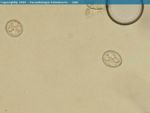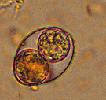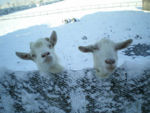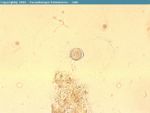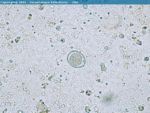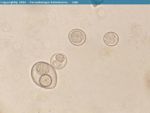| This article has been peer reviewed but is awaiting expert review. If you would like to help with this, please see more information about expert reviewing. |
|
|
Introduction
Eimeria spp.
- Many species occur
- All species are host specific
- Sporulated oocyst has 4 sporocysts which each contain 2 sporozoites
- Oocyst measures 20-50μm
- Direct life cycle
- Transmission by the oral-faecal route
Isospora spp.
- Many species occur
- All species are host specific
- Sporulated oocyst contains 2 sporocysts each with 4 sporozoites
- Oocyst measures 20-50μm
- Usually direct life cycle
- Transmission via the oral-faecal route
- Some species use facultative intermediate hosts and form tissue cysts
- Transmission via faecal-oral route or by ingestion of the intermediate host
Coccidia of Poultry
- Direct life cycle
- 1 week prepatent period
- After oocysts are ingested, sporozoites are released which penetrate the intestinal epithelium
- 2 asexual phases of multiplication called schizogony occur followed by a phase of sexual multiplication called gametogony
- Zygote develops into an oocyst which is then shed in the faeces
- Oocyst measures 20-30μm
- For each oocyst ingested, thousands are shed
- Life cycle is self-limiting
- Organisms from a single infection go through the sequence of developmental stages synchronously
- Organisms leave the body simultaneously as oocysts
- Oocysts are only infective once they have sporulated
- Sporulation requires warmth, moisture and oxygen
- Takes 2-3 days in broiler houses
- Oocysts contain 4 sporocysts each with 2 sporozoites
Pathogenesis
- 7 important Eimeria species
- 4 malabsorptive species
- Eimeria acervulina which is moderately pathogenic
- Eimeria maxima which is moderately pathogenic
- Eimeria mitis which has low pathogenicity
- Eimeria praecox which has low pathogenicity
- 3 haemorrhagic species
- Eimeria tenella
- Eimeria necatrix
- Eimeria brunetti
- All highly pathogenic
- Form large sub-epithelial second generation schizonts at the base of intestinal crypts
- Deep eruptions form when cells rupture to release merozoites
- Destruction of crypt stem cells and marked haemorrhage
- Blood stained faeces
- High morbidity and high mortality
Diagnosis
- Post-mortem diagnosis of lesion severity
- Region of intestine affected
- Appearance of lesion
- Presence or absence of haemorrhage
- Size of schizonts and oocysts found in mucosal scrapings
- Eimeria acervulina
- Proximal gut
- Thickening of walls
- 'White ladder lesions' produced by dense foci of gamonts and oocysts
- Watery exudate
- Eimeria maxima
- Mid-gut
- Thickening of walls
- Pink exudate
- Eimeria tenella
- Swollen caeca
- Thickening of wall
- Dark colouring containing a core of necrotic tissue and blood
- Lesion scoring is the best method of diagnosing the severity of the lesions and therefore the causative Eimeria species
- Eimeria necatrix
- Mid-gut
- Ballooning of wall
- White spots and petechiae forming 'salt and pepper' lesions
- Haemorrhage into lumen
Immunity
- Different Eimeria species produce different levels of protective immunity
- E.maxima -> E.brunetti and E.acervulina -> E.tenella and E.necatrix
- There is no cross immunity between species
- There is very little passive immunity
- Evokes a cell-mediated response
- All ages of poultry are susceptible
Epidemiology
- Oocysts are ubiquitous and robust
- Able to survive several months to years
- It is impossible to keep buildings free from infection
- Chicks become infected by pecking the ground shortly after being placed in the poultry house
- Biotic potential is enormous
- Generation time is short
- Massive infections can build up rapidly
- Immunity develops relatively slowly
- With high stocking densities the situation is explosive
Control
- Chemical
- Intensive poultry production is largely dependent on the use of anticoccidial drugs
- For more information see here
- Vaccines
- Paracox
- Multivalent attenuated live vaccine for replacement layers and broilers
- Contains 7 live strains of Eimeria
- Lack the most pathogenic life cycle stage making the prepatent period shorter
- Known as precocious strains
- Chicks vaccinated on a single occasion when 1-9 days old through oocyst suspension in the feed or water
- Vaccinated birds have sub-optimal growth rates so is not used for broilers
- Paracox 5
- Contains 5 strains of the most pathogenic Eimeria
- Used for broilers
- Sprayed onto the first feed offered to new batches of chicks
- Paracox
- Integrated control
- Careful management is needed so in-feed prophylaxis and vaccination do not fail
- Remove litter and thoroughly clean houses in between crops
- Optimum turn-around time is 10 days
- Use the lowest stocking density which is compatible with economic production
- Water bowls, roofs and walls should be well maintained to prevent litter becoming damp
- Stress factors should be avoided and adequate nutrition provided
Other Avian Coccidia
Coccidia of Turkeys
- 5 Eimeria species
- 2 important pathogenically
- Eimeria in the anterior and mid-intestine causes necrotic enteritis and petechial haemorrhages
- Causes watery diarrhoea in young poults and some mortality
Coccidia of Geese
- 3 Eimeria species
- 2 intestinal species causing macroscopic lesions in kidney tubules
- Oocysts carried in urine and pass out with faeces
- Renal species cause severe disease in goslings
- Depression, emaciation, diarrhoea and sometimes death
Coccidia of Ducks
- Several Eimeria species
- Another coccidia species which produces 8 sporozoites but these are not enclosed in a sporocyst
- Causes severe enteritis and mortality in ducklings
- Haemorrhages and pale focal lesions in small intestine
Coccidia of Game Birds
- 3 main species
Coccidia of Cattle
- Many species affect cattle
- Cattle under a year old are usually infected sporadically
- 2-3 week prepatent period
- Eimeria bovis
- Eimeria zuernii
- Endogenous stages in connective tissue of lamina propria of the lower small intestine and in the epithelial cells of the caecum and colon
- More pathogenic than Eimeria bovis
- Causes blood stained dysentery, tenesmus and sloughed mucosa
- Oocysts are spherical and measure 16μm
- Mainly occurs in calves in poor conditions and bought-in calves
- Also occurs in suckler calves turned out in spring
- Eimeria alabamensis associated with diarrhoea in calves after spring turnout
- Passive immunity is sufficient during the neonatal period
- Can be concurrent with cryptosporidium, viral and bacterial agents
Diagnosis
- History, clinical signs, diarrhoea (often with blood) and a decrease in weight gain
- Post-mortem
- High faecal oocyst count
- However, healthy animals can pass millions of oocysts from mixed species infections which have no pathogenic significance
- Animals may die before oocysts are shed
Control
- Improve husbandry
- Improve sanitation
- Increase bedding
- Raise food and water troughs to avoid faecal contamination
- Preventative in-feed medication
- E.g. Decoquinate
- Injectable antiprotozoals may limit oocyst production but animals should still be moved to a clean environment
- E.g. Sulphamethoxypyridazine
Coccidia of Sheep
- 11 different Coccidia species although only two are of clinical significance
- Giant schizonts visible as white spots
- Eimeria crandalis
- Varying pathogenicity
- Scours, grey, foul-smelling faeces
- Parasitises the small intestine, caecum and colon
- 2 week prepatent period
- Disease frequently seen in lambs under 6 months old
- More often in twins and triplets when single lambs
- Oocyts from ewes (immune carriers) accumulate in poorly managed litter or around feed and water troughs
- Lambs born early in the year amplify the parasite problem increasing the parasite risk to lambs born later in the year
- Affected lambs may die before oocysts are found in the faeces
- Post-mortem diagnosis difficult
- Different species of Eimeria occurs in sheep and goats
- Infection may be coincident with Neospora or Cryptosporidium infections
- Mixed infections complicate the diagnosis as oocyst differentiation is difficult
- Other non-pathogenic species can cause papillomatous mucosal growths
Control
- Improve husbandry
- Avoid overcrowding
- Decrease stress
- Improve hygiene by dagging ewes
- Avoid mixing lambs of different ages
- Preventative measures include creep feeding lambs with decoquinate or oral dosing with diclazuril when lambs are 4-6 weeks
- A second dose can be given after 3 weeks
Coccidia of Goats
- Many Eimeria species
- 2 Eimeria are pathogenic
- Cause diarrhoea and a decreased growth rate
- Different species of Eimeria occurs in sheep and goats
Coccidia of Horses
- Only one atypical Eimeria
- Forms large subepithelial gametocytes in villi
- Large, dark coloured oocysts
- Approximately 12μm
- Occasionally causes diarrhoea
- Besnoitia bennetti in larynx of horses
Coccidia of Pigs
- Many species of Eimeria and Isospora
- Only Isospora suis is of clinical pathogenic importance
- Causes sporadic, serious and sometimes fatal disease in unweaned piglets
- Causes profuse diarrhoea
- Very short 1 week prepatent period
- Diarrhoea starts before oocysts are shed in faeces
- Ante-mortem diagnosis is difficult
- Death usually occurs after parasites have left the host
- Post-mortem diagnosis difficult
- Isospora infections are self-limiting
Coccidia of Dogs
- 2 common and 2 less common Isospora species
- Occasionally can cause disease
- Little pathogenicity
- Even if faecal oocyst count is high, other causes of diarrhoea should be looked for
- Hepatozoon americanum and subclinical H. canis in periosteal bone formation
- Both are Tick borne diseases
- H. canis – Rhipicephalus sanguineus
- Ticks become infected by ingesting a blood meal containing macrophages and neutrophils infected with the parasite gamonts -> sexual replication in the gut of the tick -> oocysts containing infective sporozoites -> dogs ingest the tick schizogony occurs in numerous tissues
- Both are Tick borne diseases
Coccidia of Cats
- 2 common Isospora species with little clinical significance
- Oocysts in faeces have to be distinguised from those of Toxoplasma (smaller) and Sarcocytis (sporulated or naked sporocyts in faeces)
Coccidia of Rabbits
- 3 pathogenic Eimeria species
- 2 in the caecum
- 1 in the bile duct
- Eimeria steidae
- Serious disease of both pet and farmed rabbits
- Treatment is by administration of drugs in drinking water
- E.g. Toltrazuril
- Hygiene is the best method of prevention to prevent sporocysts from sporulating
- Medicated feed can be used in commercial units
- E.g. Rabenidine
